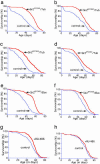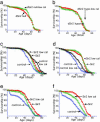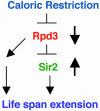Sir2 mediates longevity in the fly through a pathway related to calorie restriction
- PMID: 15520384
- PMCID: PMC528752
- DOI: 10.1073/pnas.0404184101
Sir2 mediates longevity in the fly through a pathway related to calorie restriction
Abstract
Calorie restriction can extend life span in a variety of species including mammals, flies, nematodes, and yeast. Despite the importance of this nearly universal effect, little is understood about the molecular mechanisms that mediate the life-span-extending effect of calorie restriction in metazoans. Sir2 is known to be involved in life span determination and calorie restriction in yeast mother cells. In nematodes increased Sir2 can extend life span, but a direct link to calorie restriction has not been demonstrated. We now report that Sir2 is directly involved in the calorie-restriction life-span-extending pathway in Drosophila. We demonstrate that an increase in Drosophila Sir2 (dSir2) extends life span, whereas a decrease in dSir2 blocks the life-span-extending effect of calorie reduction or rpd3 mutations. These data lead us to propose a genetic pathway by which calorie restriction extends life span and provides a framework for genetic and pharmacological studies of life span extension in metazoans.
Figures




References
-
- Masoro, E. J. (2000) Exp. Gerontol. 35, 299–305. - PubMed
-
- Lane, M. A., Mattison, J., Ingram, D. K. & Roth, G. S. (2002) Microsc. Res. Tech. 59, 335–338. - PubMed
-
- Mattison, J. A., Lane, M. A., Roth, G. S. & Ingram, D. K. (2003) Exp. Gerontol. 38, 35–46. - PubMed
-
- Wanagat, J., Allison, D. B. & Weindruch, R. (1999) Toxicol. Sci. 52, 35–40. - PubMed
-
- Weindruch, R. (1996) Toxicol. Pathol. 24, 742–745. - PubMed
Publication types
MeSH terms
Substances
Grants and funding
LinkOut - more resources
Full Text Sources
Other Literature Sources
Molecular Biology Databases

